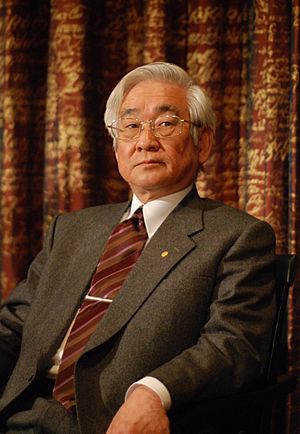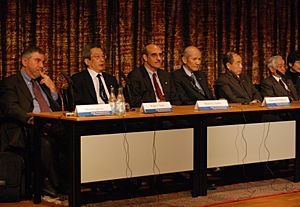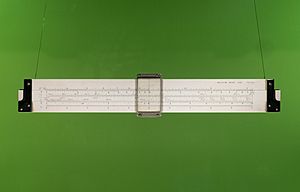Toshihide Maskawa facts for kids
Quick facts for kids
益川 敏英
Toshihide Maskawa |
|
|---|---|

Maskawa in 2008
|
|
| Born | 7 February 1940 |
| Died | 23 July 2021 (aged 81) Kyoto, Japan
|
| Nationality | Japanese |
| Alma mater | Nagoya University |
| Known for | Work on CP violation CKM matrix |
| Awards | Sakurai Prize (1985) Japan Academy Prize (1985) Asahi Prize (1994) Nobel Prize in Physics (2008) |
| Scientific career | |
| Fields | High energy physics (theory) |
| Institutions | Nagoya University Kyoto University Kyoto Sangyo University |
| Thesis | 粒子と共鳴準位の混合効果について. (1967) |
| Doctoral advisor | Shoichi Sakata |
Toshihide Maskawa (or Masukawa) (益川 敏英, Masukawa Toshihide, 7 February 1940 – 23 July 2021) was a Japanese theoretical physicist. He was famous for his work on something called CP violation. This work helped explain why our universe has more matter than antimatter.
In 2008, he won one quarter of the Nobel Prize in Physics. He shared the award for discovering how a "broken symmetry" works. This discovery also predicted there are at least three types of tiny particles called quarks.
Contents
Early Life and Learning
Maskawa was born in Nagoya, Japan. After World War II, his family ran a sugar business. He went to Nagoya University and finished his first degree in 1962.
He then earned his Ph.D. in particle physics from the same university in 1967. His teacher was a physicist named Shoichi Sakata.
From a young age, Maskawa loved learning new things. He studied mathematics, chemistry, and even linguistics. In high school, he enjoyed reading novels, especially detective and mystery stories.
His Amazing Work in Physics
In the early 1970s, Toshihide Maskawa worked at Kyoto University. He teamed up with another physicist, Makoto Kobayashi. They worked on explaining "broken symmetry," also known as CP violation. This was part of the Standard Model of particle physics, which describes how the universe's smallest particles behave.
Their theory suggested that there must be at least three groups, or generations, of quarks. Quarks are tiny building blocks of matter. This idea was proven true just four years later when scientists found the bottom quark.
Maskawa and Kobayashi wrote an important paper in 1973. It was called "CP Violation in the Renormalizable Theory of Weak Interaction." This paper is one of the most referenced in high energy physics history. Their work also led to the Cabibbo–Kobayashi–Maskawa matrix. This is a special table that helps explain how different quarks mix together.
For this groundbreaking work, Kobayashi and Maskawa shared half of the 2008 Nobel Prize in Physics. The other half went to Yoichiro Nambu.
Maskawa was also a director at the Yukawa Institute for Theoretical Physics from 1997 to 2003. He held important positions at Nagoya University and Kyoto Sangyo University. He was also a professor emeritus at Kyoto University.
Nobel Prize Speech
On December 8, 2008, Toshihide Maskawa gave his Nobel lecture. It was titled "What Did CP Violation Tell Us?" He gave his speech in Japanese at Stockholm University. He started by saying, "Sorry, I cannot speak English." The audience followed along by reading subtitles on a screen.
Later Life and Passing
Maskawa passed away on July 23, 2021, in Kyoto, Japan. He was 81 years old.
Awards and Honors

Toshihide Maskawa received many awards for his important work, including:
- 1979 – Nishina Memorial Prize
- 1985 – Sakurai Prize
- 1985 – Japan Academy Prize
- 1995 – Asahi Prize
- 1995 – Chu-Nichi Culture Prize
- 2007 – High Energy and Particle Physics Prize by European Physical Society
- 2008 – Nobel Prize in Physics
- 2008 – Order of Culture
- 2010 – Member of Japan Academy
His Views on Society

In 2013, Maskawa and another Nobel winner, Hideki Shirakawa, spoke out against a new Japanese law. This law was about keeping government secrets. Maskawa had strong beliefs about certain topics:
- He supported Article 9 of the Japanese Constitution. This article says Japan will not have a military for war.
- He did not agree with Japanese politicians visiting the Yasukuni Shrine.
- He supported a system where married couples could choose to keep their own last names.
See also
 In Spanish: Toshihide Maskawa para niños
In Spanish: Toshihide Maskawa para niños
- Progress of Theoretical Physics
- List of Japanese Nobel laureates
- List of Nobel laureates affiliated with Kyoto University

